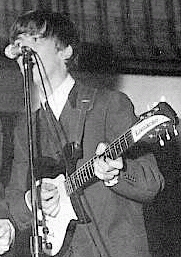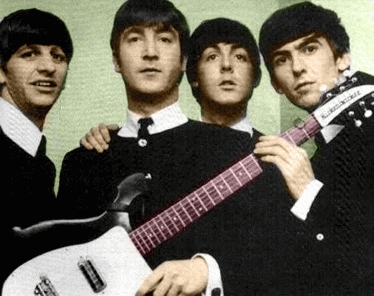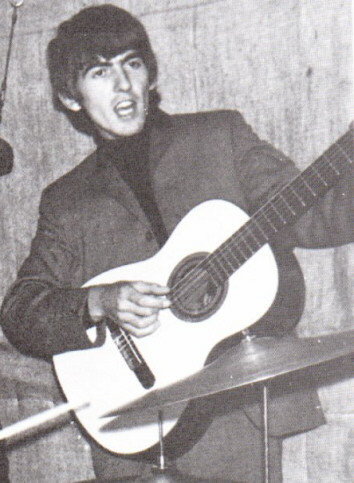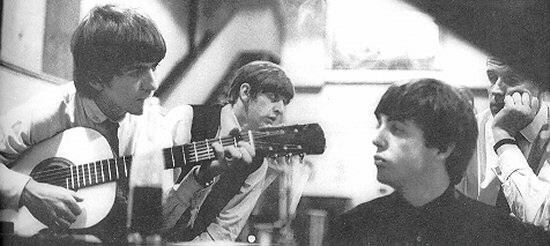 1963: 1962
Rickenbacker 425 Fire-glo solidbody. Serial
No. BH-439.
Harrison picked this up
for $400 in September '63 at Fenton's Music Store in
Mount Vernon,
Illinois,
during a two-week trip with his brother Peter to visit
their sister
Louise,
who was living a few miles away in Benton. It is
not possible to
do a more comprehensive report on this guitar than that
already done by
Peter McCormack, so I will but summarize and recommend a
visit to his
excellent
piece titled "You
Won't
See Me." In Benton Harrison met Gabe
McCarty of
the
the Four Vests, a local musical group that played
popular standards,
and
when the young Englishman mentioned he'd like to buy a
Rickenbacker
while
in the States, McCarty drove him up the road a piece to
Mount Vernon
and
introduced him to Lester "Red" Fenton. Red did have a
Rick on hand -- a
single-pickup 425 in Fire-glo. Harrison admired
the "cresting
wave"
solidbody but wanted one in black to match Lennon's
now-painted 325, so
the accommodating shopkeeper refinished the 425 in black
polyester and
had it ready for the guitarist by the time he flew home
the next
week.
A few days after his return, on 4 October, Harrison
debuted the 425 on
Britain's "Ready, Steady, Go!" TV show, telling an
admiring Dusty
Springfield
"I made it myself." A couple weeks later it's seen
again on the
"Thank
Your Lucky Stars" program. After that Harrison used it
for the Swedish
tour (late October) and the British tour (November and
December).
Interestingly, while the band's van was parked outside a
Glascow
theater,
some miscreant broke into it and stole the 425, but it
was quickly
recovered.
Back in London the guitar played a return engagement on
"Thank Your
Lucky
Stars" on 15 December. When he got his next Rick a
few weeks
later
in New York, this one was summarily retired but
apparently not
forgotten,
for at some point he added a second "toaster top" pickup
and another
switch,
and replaced the control knobs. 1963: 1962
Rickenbacker 425 Fire-glo solidbody. Serial
No. BH-439.
Harrison picked this up
for $400 in September '63 at Fenton's Music Store in
Mount Vernon,
Illinois,
during a two-week trip with his brother Peter to visit
their sister
Louise,
who was living a few miles away in Benton. It is
not possible to
do a more comprehensive report on this guitar than that
already done by
Peter McCormack, so I will but summarize and recommend a
visit to his
excellent
piece titled "You
Won't
See Me." In Benton Harrison met Gabe
McCarty of
the
the Four Vests, a local musical group that played
popular standards,
and
when the young Englishman mentioned he'd like to buy a
Rickenbacker
while
in the States, McCarty drove him up the road a piece to
Mount Vernon
and
introduced him to Lester "Red" Fenton. Red did have a
Rick on hand -- a
single-pickup 425 in Fire-glo. Harrison admired
the "cresting
wave"
solidbody but wanted one in black to match Lennon's
now-painted 325, so
the accommodating shopkeeper refinished the 425 in black
polyester and
had it ready for the guitarist by the time he flew home
the next
week.
A few days after his return, on 4 October, Harrison
debuted the 425 on
Britain's "Ready, Steady, Go!" TV show, telling an
admiring Dusty
Springfield
"I made it myself." A couple weeks later it's seen
again on the
"Thank
Your Lucky Stars" program. After that Harrison used it
for the Swedish
tour (late October) and the British tour (November and
December).
Interestingly, while the band's van was parked outside a
Glascow
theater,
some miscreant broke into it and stole the 425, but it
was quickly
recovered.
Back in London the guitar played a return engagement on
"Thank Your
Lucky
Stars" on 15 December. When he got his next Rick a
few weeks
later
in New York, this one was summarily retired but
apparently not
forgotten,
for at some point he added a second "toaster top" pickup
and another
switch,
and replaced the control knobs.  In
1971, Harrison gave this guitar to George Peckham, a
mate from
Liverpool
(he played in Earl Royce and the Olympics, and later as
rhythm
guitarist
for the Fourmost) who had become cutting engineer for
Apple and rhythm
guitarist for a new band, Matchbox. Harrison
learned the band was
about to appear on "Top of the Pops" but Peckham had no
guitar, so
Harrison
loaned him "Rocky," his psychedelic-painted Fender
Stratocaster.
When Peckham returned it, Harrison asked him if he
wanted a guitar, and
offered him the 425, calling it a "great rhythm
player."
Peckham
kept it until September 1999, when he put it up for
auction it at
Christie's.
Although the auction was posted as completed, for some
reason the high
bidder rescinded his bid, and the auction house brokered
a sale to
another
party for £56,500 (about $90,000).
Christie's records
are confidential, but soon after the sale, the Rock and
Roll Hall of
Fame
received this guitar on indefinite loan from one Sharon
Mineroff, who
reportedly
was apprehensive about keeping it in the house. So
there it sits
in Cleveland, not that far from where Harrison found it. In
1971, Harrison gave this guitar to George Peckham, a
mate from
Liverpool
(he played in Earl Royce and the Olympics, and later as
rhythm
guitarist
for the Fourmost) who had become cutting engineer for
Apple and rhythm
guitarist for a new band, Matchbox. Harrison
learned the band was
about to appear on "Top of the Pops" but Peckham had no
guitar, so
Harrison
loaned him "Rocky," his psychedelic-painted Fender
Stratocaster.
When Peckham returned it, Harrison asked him if he
wanted a guitar, and
offered him the 425, calling it a "great rhythm
player."
Peckham
kept it until September 1999, when he put it up for
auction it at
Christie's.
Although the auction was posted as completed, for some
reason the high
bidder rescinded his bid, and the auction house brokered
a sale to
another
party for £56,500 (about $90,000).
Christie's records
are confidential, but soon after the sale, the Rock and
Roll Hall of
Fame
received this guitar on indefinite loan from one Sharon
Mineroff, who
reportedly
was apprehensive about keeping it in the house. So
there it sits
in Cleveland, not that far from where Harrison found it.
Note: When
Rickenbacker
first introduced
the 425 in 1958 it had no vibrato; in 1965
Rickenbacker added a
vibrato
unit to the 425 and designated the vibrato-less 425
as model 420.
|
 1963: Jose
Ramirez Guitarra de Estudio acoustic (vintage
unknown): One of the
first specialty items added to Harrison's collection;
this Spanish
nylon-string
guitar was miked and used for his delicate lead work on
"Til There Was
You" and "And I Love Her." This mid-priced model
features an
extended
fingerboard on the first three strings. I'm
guessing that
Harrison
still has it.
1963: Jose
Ramirez Guitarra de Estudio acoustic (vintage
unknown): One of the
first specialty items added to Harrison's collection;
this Spanish
nylon-string
guitar was miked and used for his delicate lead work on
"Til There Was
You" and "And I Love Her." This mid-priced model
features an
extended
fingerboard on the first three strings. I'm
guessing that
Harrison
still has it.

 1963: 1962
Rickenbacker 425 Fire-glo solidbody. Serial
No. BH-439.
Harrison picked this up
for $400 in September '63 at Fenton's Music Store in
Mount Vernon,
Illinois,
during a two-week trip with his brother Peter to visit
their sister
Louise,
who was living a few miles away in Benton. It is
not possible to
do a more comprehensive report on this guitar than that
already done by
Peter McCormack, so I will but summarize and recommend a
visit to his
excellent
piece titled
1963: 1962
Rickenbacker 425 Fire-glo solidbody. Serial
No. BH-439.
Harrison picked this up
for $400 in September '63 at Fenton's Music Store in
Mount Vernon,
Illinois,
during a two-week trip with his brother Peter to visit
their sister
Louise,
who was living a few miles away in Benton. It is
not possible to
do a more comprehensive report on this guitar than that
already done by
Peter McCormack, so I will but summarize and recommend a
visit to his
excellent
piece titled  In
1971, Harrison gave this guitar to George Peckham, a
mate from
Liverpool
(he played in Earl Royce and the Olympics, and later as
rhythm
guitarist
for the Fourmost) who had become cutting engineer for
Apple and rhythm
guitarist for a new band, Matchbox. Harrison
learned the band was
about to appear on "Top of the Pops" but Peckham had no
guitar, so
Harrison
loaned him "Rocky," his psychedelic-painted Fender
Stratocaster.
When Peckham returned it, Harrison asked him if he
wanted a guitar, and
offered him the 425, calling it a "great rhythm
player."
Peckham
kept it until September 1999, when he put it up for
auction it at
Christie's.
Although the auction was posted as completed, for some
reason the high
bidder rescinded his bid, and the auction house brokered
a sale to
another
party for £56,500 (about $90,000).
Christie's records
are confidential, but soon after the sale, the Rock and
Roll Hall of
Fame
received this guitar on indefinite loan from one Sharon
Mineroff, who
reportedly
was apprehensive about keeping it in the house. So
there it sits
in Cleveland, not that far from where Harrison found it.
In
1971, Harrison gave this guitar to George Peckham, a
mate from
Liverpool
(he played in Earl Royce and the Olympics, and later as
rhythm
guitarist
for the Fourmost) who had become cutting engineer for
Apple and rhythm
guitarist for a new band, Matchbox. Harrison
learned the band was
about to appear on "Top of the Pops" but Peckham had no
guitar, so
Harrison
loaned him "Rocky," his psychedelic-painted Fender
Stratocaster.
When Peckham returned it, Harrison asked him if he
wanted a guitar, and
offered him the 425, calling it a "great rhythm
player."
Peckham
kept it until September 1999, when he put it up for
auction it at
Christie's.
Although the auction was posted as completed, for some
reason the high
bidder rescinded his bid, and the auction house brokered
a sale to
another
party for £56,500 (about $90,000).
Christie's records
are confidential, but soon after the sale, the Rock and
Roll Hall of
Fame
received this guitar on indefinite loan from one Sharon
Mineroff, who
reportedly
was apprehensive about keeping it in the house. So
there it sits
in Cleveland, not that far from where Harrison found it.